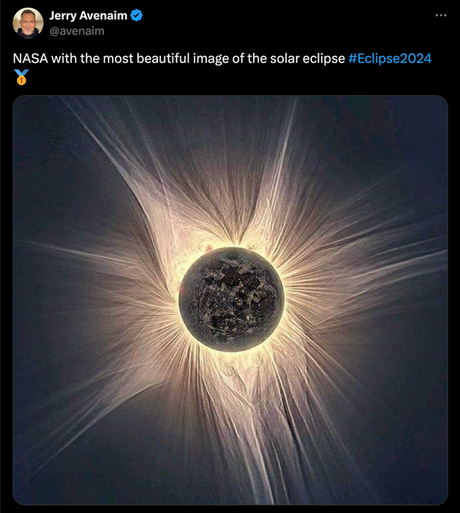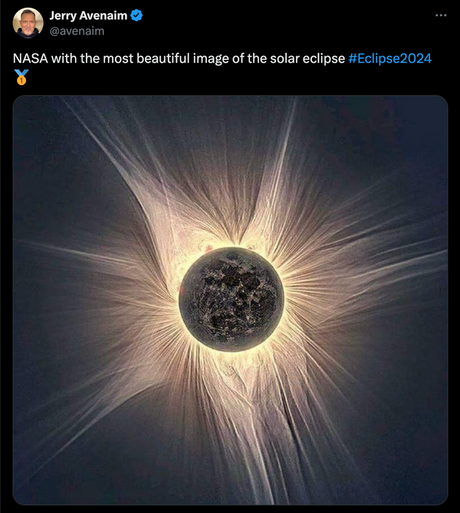A real photo taken by NASA's James Webb Space Telescope (JWST) shows the April 8, 2024 solar eclipse.
Judgement: 

The real photo [pictured above] was not created by JWST nor will it be in 2024. The image that went viral is a digital drawing that accurately recreates the photo.
The essayist Annie Dillard once wrote about a solar eclipse that "what you see at an eclipse is completely different from what you know." Perhaps this is why the best part of total solar eclipses is looking at some of the absolutely stunning photos circulating on social media.
After the solar eclipse that passed over North America on April 8, 2024, messages on X (formerly Twitter) went viral claiming that NASA's own James Webb Space Telescope (JWST) had the best photo.


Snopes investigated the origin of the photo at the request of readers. We found a photo that looks very similar to the one posted online: it's the photo used in our header image. However, that photo was not taken by NASA's JWST, nor is it of the 2024 solar eclipse. A reader tipped us off that the exact image in the viral post was actually a reproduction of the same photo we discovered, taken by an artist named Cathrin Machin. This is what we found:
First we did research social media profiles from NASA and JWST - we thought the scientists and astronomers who took the photo would be proud of the telescope shot and post about it.
Count us out of here! Webb's infrared optics detect extremely weak heat signals, and the Earth, moon, and sun are *all* far too bright and hot to ever look their way. That's why we have a sunscreen: https://t.co/tTGIWqFAz8 https://t.co/wRTZNO4i6u
- NASA Webb Telescope (@NASAWebb) April 3, 2024
Instead, we found messages from the official JWST JWST is specially designed with a lens hood to prevent sunlight from interfering with the instruments. This means that the image could never have been made by Webb.
The story continues
We then ran the image through reverse image search engines like TinEye and Google Lens, which gave us mixed results. While TinEye found no matches, Google Lens came up with several, many of which we noticed were posted before the April 8 solar eclipse. So the image is not only of JWST, but also not of the 2024 North American solar eclipse.
It does indeed show a solar eclipse in North America - it is precisely the one that occurred on August 21, 2017. Several of the links provided by the Google Lens search attributed the photo to Dr. Sebastian Voltmer, a filmmaker and astrophotographer.
By looking at Voltmer's social media, we confirmed that he took the original photo, with the best version of the photo coming from his Flickr page. According to details in the Flickr caption, Voltmer captured the image with a telescope in Wyoming using a photographic technique called HDR, which combines several images taken at different exposure lengths to best capture detail in high-resolution images. light/dark contrast. When Voltmer posted the photo on social media he rotated it 90 degrees to fit a vertical aspect ratio.
Total solar eclipse HDR image captured with my D800 through a C80 ED refractor telescope.
Even with the naked eye I could see Earthshine while looking at the star Regulus (peripheral vision).Image: @SeVoSpace
On April 8, the great total solar eclipse will cross the north... pic.twitter.com/DJYz8UjWPs
-Dr. Sebastian Voltmer (@SeVoSpace) April 6, 2024
In 2020, Australian artist Cathrin Machin took Voltmer's social media image and redesigned it in painstaking detail over the course of ten days. If you compare Machin's version, posted on her Instagram page, to the versions that went viral after the 2024 solar eclipse, the colors matched exactly. We suspect that Machin's image is mirrored and filtered, which may be why we didn't find it using reverse image search sites like TinEye.
So no, the image in question was not taken by the James Webb Space Telescope. Don't take it as a shame about JWST's limitations, though; instead, think of it more as a tribute to the telescope, which has changed our perception of astronomical imaging since its launch. Astrophotographers like Voltmer, who managed to take an absolutely stunning photo of the Earth's surface, and talented artists like Machin who add even more.
Sources:
"ABOUT." Website by Dr. Sebastian Voltmer July 14, 2011, https://voltmer.de/about/.
Kool, Margherita. "Artist spends 10 days recreating the spectacular sight of a solar eclipse." My modern encounter February 1, 2021, https://mymodernmet.com/cathrin-machin-solar-eclipse-digital-painting/.
Google Lens. https://lens.google.com/search?ep=gsbubb&hl=en&re=df&p=AbrfA8pDj-eLtdBoFywOYPGl4J91aRHmjGVQqI3LFDW_ZIupy_e5ttLrKsKYze_-AezMBfFTUwqRZ8hQX7FML4bSZmY8Lq2cmLWfbZ6KeND01zC85cunVp2hz7JWn_ow7639FpB_UleoKfrwOVO4TSK08XvB9ZDzBEhF0E1JNExWlkJlqtuj5KKaOKtZy3tcDFgqCnkfcbKGJeMvq0NkMrcW1MvvApBFkG4TaqIKd537awA467LJlXf5fX5QVU31nPzVtZSpU69GJmHumMJmqKur3q0_r0Lz4g%3D%3D#lns=W251bGwsbnVsbCxudWxsLG51bGwsbnVsbCxudWxsLDEsIkVrY0tKR0pqTW1ZM05XWXpMV0U1WVdVdE5EQXlOQzFoT0daakxUWTNOREkzTlRGaE9ESTJNUklmT0hsa1FrMDBOSFJZVDNkaGEwaDRiR3BST0hJemVEbEpSMWc0TnpkQ1p3PT0iLG51bGwsbnVsbCxbW251bGwsbnVsbCwiMy0zIixudWxsLDgwXSxbImUwN2NlYWFiLTI4YTUtNDJiMy04YjdiLTliZTI3MjIyMTEzMyJdXSxudWxsLG51bGwsbnVsbCxbbnVsbCxudWxsLFtdXV0=. Accessed April 9, 2024.
" https://Twitter.Com/Avenaim/Status/1777442521209282862/Photo/1." X (formerly Twitter), https://twitter.com/avenaim/status/1777442521209282862/photo/1. Accessed April 9, 2024.
" https://Twitter.Com/NASAWebb/Status/1775629331357642755." X (formerly Twitter), https://twitter.com/NASAWebb/status/1775629331357642755. Accessed April 9, 2024.
" https://Twitter.Com/SeVoSpace/Status/1776736821617319995." X (formerly Twitter), https://twitter.com/SeVoSpace/status/1776736821617319995. Accessed April 9, 2024.
Instagram. https://www.instagram.com/p/C5b41osy-C2/?hl=en. Accessed April 9, 2024.
Instagram. https://www.instagram.com/p/CC3S10SgYoc/?img_index=1. Accessed April 11, 2024.
The Webb/NASA sunshade. https://webb.nasa.gov/content/observatory/sunshield.html. Accessed April 9, 2024.
TinEye Reverse Image Search. https://tineye.com/search/ea998d3f04d504ce8c8ace8ca9be5800e321d6e0?sort=score&order=desc&page=1. Accessed April 9, 2024.
Voltmer, Sebastian. Corona Earthshine 2017. photo, September 6, 2017. Flickr https://www.flickr.com/photos/spacemovie/36659081780/.
